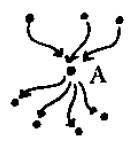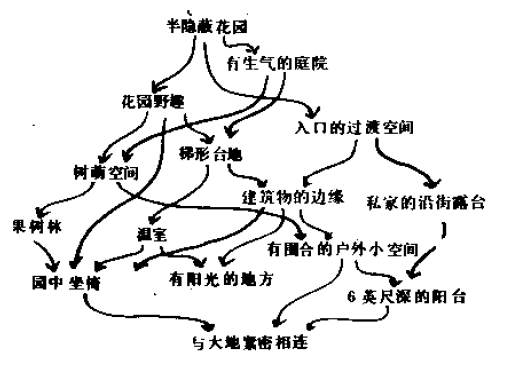這是建築的永恆之道的第十六章語言的結構,前言這樣寫『一旦我們懂得瞭如何發現有生氣的單個模式,我們便可以為我們自己,為我們所遇到的建築任務,編制一種語言。語言的結構是由單個模式之間的連繫網產生的;語言作為一個總體,其生存與否取決於這些模式形成一個整體的程度。』全文可以從建筑的永恒之道——第十六章 语言的结构(1)、建筑的永恒之道——第十六章 语言的结构(2)讀取,本文不贅述,不過簡體版書有少了幾頁沒譯出來,所以讀者可以在此看出大概。

『那麼,很清楚,我們可以發現有活力的模式,並可以共享它們,從而對它們的現實的信任達到某種適當的程度。
模式包括我們周圍的任何尺度範圍:最大的模式包括區域結構,中等範圍的包括建築的形狀和活動,最小的模式涉及建築賴以建成所必需的具體物質材料和結構。
不過到現在為止,我們幾乎沒有談論語言。在這一章裡,我們將看到怎樣才可能把這些模式放在一起,形成連貫的語言。
…
設想我要建一個花園。』ㄚ琪家倒是想建一個菜園。
| 半隱蔽花園 | 果樹林 |
| 重疊交錯的屋頂 | 樹蔭空間 |
| 花園野趣 | 有圍台的戶外小空間 |
| 入口的過渡空間 | 六英尺深的陽台 |
| 有生氣的庭院 | 與大地緊密相連 |
| 屋頂花園 | 溫室 |
| 建築物邊界線 | 園中座椅 |
『模式語言的結構由個別模式並不獨立這樣的事實產生的。
…
每一模式既依賴於它包含的較小模式,也依賴於包含它的更大的模式。
…
每個模式位於一個連繫網的中心,把它同幫助它完滿的其它模式連結在一起。』
模式間的關聯畫法讓人感到非常地熟悉。
一對多或多對一?
『是模式間的這些聯繫網產生了語言。』
花園的語言結構,好複雜喔。
『的確,是這種網狀結構使各單個模式具有意義,因為它把它固定住,使它們完滿。
…
但是,雖然我已把模式互相連接成網絡而形成一種語言,我怎麼知道語言是好的呢?』
…
當語言在形態上和功能上完滿的時候,它就是一個能夠使某種東西完整的好的語言。
…
當我可以想像語言非常具體產生的那種建築時,語言就是形態上完滿的。
…
當語言限定的模式系統能夠充分允許所有內力自己解決時,語言就是功能上完滿的。
…
在兩種情形中,只有當語言中所有單個模式完滿時,語言才是完滿的。
…
因此,一旦需要填充每一不完滿的模式,我們就必須創造新模式。
…
但我也必須保證給定模式之下的那些模式是其基本的組成部分。
…
把任一給定模式的基本組成部分的模式同那些更下一層次的模式區別開來是根本的。
…
實際上,這意味看你準備的語言必須經過評判,好像它本身是一個完成的花園(或完成的建築)。』
簡體版中闕漏的原文,ㄚ琪補一些繁體的摘要,不全翻:
And this process of defining the principal components of a given pattern is what finally completes it.
是對給定模式主要組成部份進行限定這個過程最後完成這一模式的。
Originally we think, perhaps, that the main parts of a “garden” are lawns, and flower beds, and paths.
But now, after careful consideration of the pattern HALF-HIDDEN GARDEN, we begin to see that it has five main components: GARDEN GROWING WILD, PRIVATE TERRACE ON THE STREET, SUNNY PLACE, TREE PLACES, and GARDEN WALL.
Now our whole functional and morphological understanding of the garden has changed. It is not only that we now see the garden as made up of these particular five new entities, which changes our vision of the garden’s form. The fact that these five patterns solve five particular problems also changes entirely, our vision of the garden’s function.
When every pattern has its principal components given by the smaller patterns which lie immediately below it in the languagey then the language is complete.
當對每個模式有了基本的組成部分,而基本的組成部分又由語言中這個模式支下的更小的模式給定時,語言就完滿了。
And you see then what a beautiful structure a pattern language has.
Each pattern is itself a part of some larger pattern—it is born out of these larger patterns through the forces which occur there, and the conditions which allow these forces to be in harmony.
And each pattern itself gives birth to smaller patterns which, once again, through forces which must also be in harmony, gives birth to smaller patterns again created by the conditions which put the lower level forces into harmony.
Now we can see the full extent to which the design of the garden lies within the language for the garden.
If you like the family of gardens which your garden language generates, then the language is fine; but if the language does not conjure up an image of a marvelous place, then there is something wrong with it; and what is wrong can’t possibly be corrected later when you get to the process of design. At that stage it is much too late.
We tend to imagine that the design of a building or a garden takes a long time; and that the preparation for the process of design is short. But in the process where the language plays its proper part, this gets reversed. The preparation of the language may take a very long time: weeks, months, years. But the use of the language, as we shall see concretely in chapters 21 and 22 and 23, takes no more than a few hours.
『實際上,這意味看你準備的語言必須經過評判,好像它本身是一個完成的花園(或完成的建築)。
…
於是,任何設計過程的真正工作在於整理語言,之後你可以從中產生一個特殊的設計。
你首先必須形成語言,因為是語言的結構和關聯決定了設計。你建造的個別建築依據你所使用的語言的深度與完整性,將富有活力或沒有活力。
當然,一旦你形成了語言,這個語言就是有普遍性的它有能力產生一個有生命力的建築,它就可以用上千百次,產生千百個有活力的建築。』
讀後,ㄚ琪這樣想,一旦我們學會了韓語,就可以產生一個有生命力的旅遊,這倒是一件很有趣的發現,一邊學韓語,一邊規劃韓國的旅行,這樣的模式可以一直地複製到其他的語言結構的國家,並且可以去旅遊的時候拜訪得知,真的是一個很奇特的體驗。



